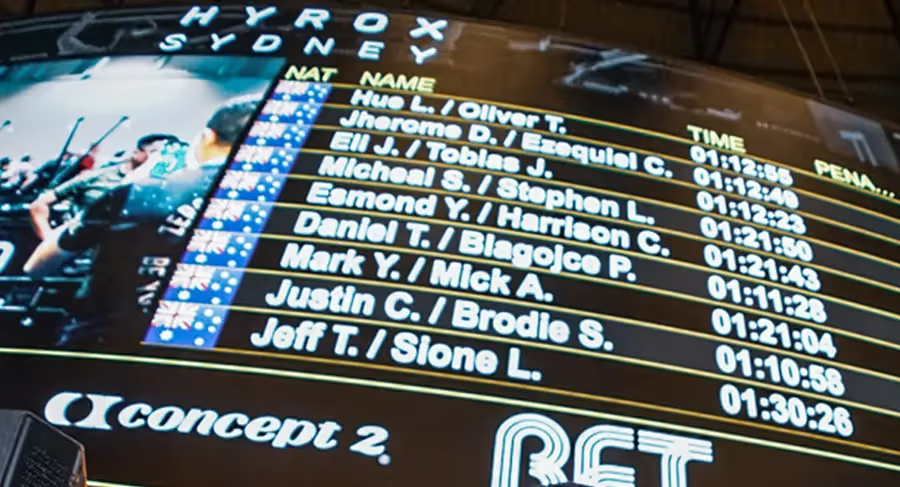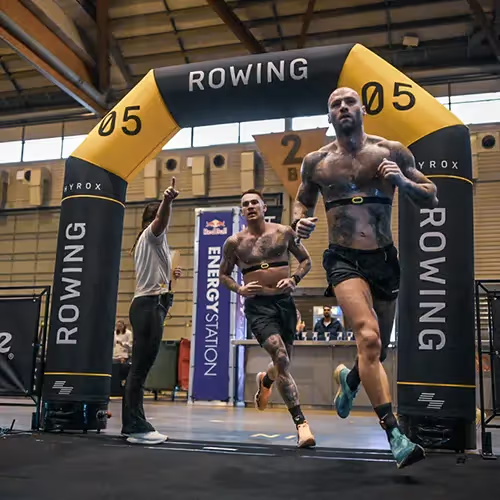What is a good HYROX time?
We created this article not to impose expectations about what a “good performance” should look like but more so to give anyone preparing a HYROX race a set of



We created this article not to impose expectations about what a “good performance” should look like but more so to give anyone preparing a HYROX race a set of


We created this article not to impose expectations about what a “good performance” should look like but more so to give anyone preparing a HYROX race a set of standard references to gauge where they fall and help them set realistic race goals for themselves.
Remember that a good performance is the performance that leaves you proud of the hard work you’ve put in.
If you’ve put in consistent time and effort in training and have improved your health and fitness you’re already a race winner.
But by establishing set times that make sense for YOU and YOUR goals it can be easier to have a target to push for and motivate you.
So let’s take a look at time expectations for different categories at different levels of fitness and preparation for those categories as well as ways to establish a good target time to chase for yourself.
Yourself against your own limitations

Here we have a display of the average times recorded for each HYROX race category possible. This is a great place to start to begin understanding where you might fall based on your fitness and category of choice.
HYROX Men – 1:35:00
HYROX Women – 1:38:02
HYROX Men DOUBLES – 1:19:22
HYROX Women DOUBLES – 1:28:43
HYROX Mixed DOUBLES – 1:25:26
HYROX PRO Men – 1:30:41
HYROX PRO Women – 1:31:22
Once you’ve found the average time for your category, it’s time to start calculating where you might fall on the average timeline.
However there is one crucial point to account for: these averages are largely impacted by the fact that a lot of the scores are contributed by athletes who’ve already completed multiple HYROX races.
Therefore these racers will be fitter than the general population completing their first HYROX, and on top of that will have valuable experience under their belt to help them shave off minutes from their race time.
Meaning the average times reported are not fully indicative of the average time of a “first time racer” in HYROX.
Do keep this in mind when trying to estimate where you may fall on the finishing time curve.

To set a target time for yourself you first must start understanding what is a “doable” finishing time for you. Meaning a time you can estimate you’d relatively easily complete the race in. That will be your starting point to establish what is then a GOOD time for you to finish the race in.
To do so, the first thing that must be done is estimate the time you will take to run each kilometer segment of the race and multiply that by 8.
So for example if you can sustainably run 1km in 6:00 minutes that will take up 48:00 total minutes of your race time leaving you to then estimate the average time of the 8 stations (burpee broad jump, sled pull, sled push ...)
Estimating each station’s time will be much more complicated but having a starting point of reference from the run can be extremely useful. You can take average times for each station and sum them to your running time. Or you can calculate an average time for yourself to sum to the run time.
To this sum you’ll finally add somewhere between 3 and 7 minutes of ROX zone time (= the time spent transitioning between race track and station zones).

We always recommend over-estimating here as on race day there will be several unpredictable variables such as transitions, other people on the race track, likelihood of a heavier sled and just general nerves.
The resulting total time calculated will be the time reference from which you can deduct anywhere between 10 to 15%. This can become your goal time and anywhere between goal time and reference time is where you might fall on the finishing times curve giving you an idea of where you’re currently at in the competition field.
Now the question may become, especially if you have a very competitively wired brain:
What time do I need to clock in to become one of the best?
Talking about the more competitive categories we can usually estimate that:
If you aim to qualify for the World Championships in your division we recommend looking at average stats for your category on the HYROX website.

Improving on a previous time or beating a goal time in a HYROX race will depend on several factors, from how you train and having a proper training plan, to optimizing nutrition and strategy, to working on your technique on both running and stations and much more.
The best way to start is to get on a consistent training plan that doesn’t just offer a smart training structure but consistent tips, tricks and technical explanations to help you improve your fitness but prepare in a sport-specific manner for race day. You can check out our official HYROX program:
Training smart, with commitment and a goal in mind is often the most important pillar to beating your goals but having knowledgeable coaches along the way can make such a difference for the better.
No matter your choice, show up every day with intent and do your research on seemingly secondary aspects like race day nutrition, proper hydration, movement standards and possible risks to get penalties as well as what to expect on race day which might be missing from a gym simulation.